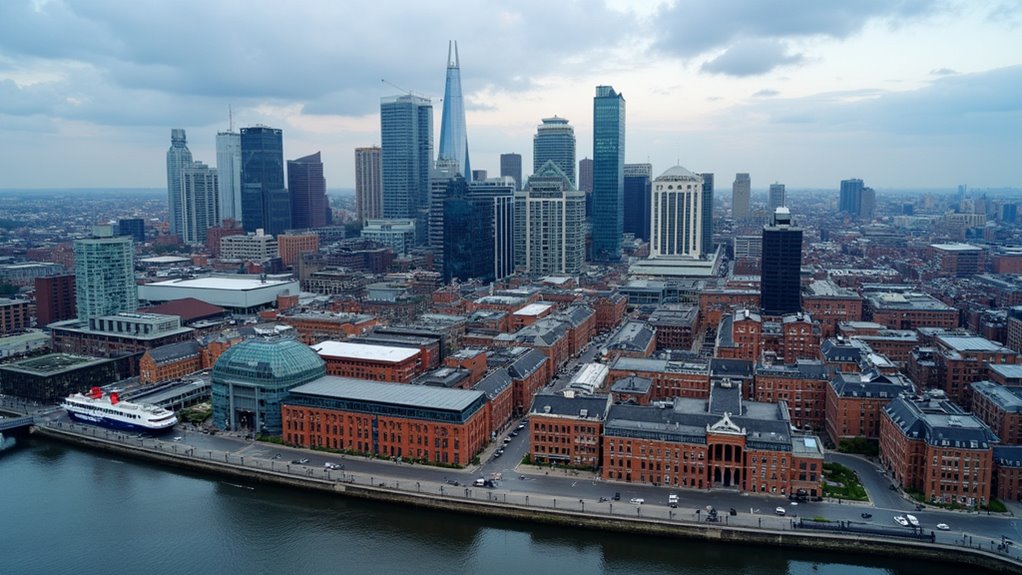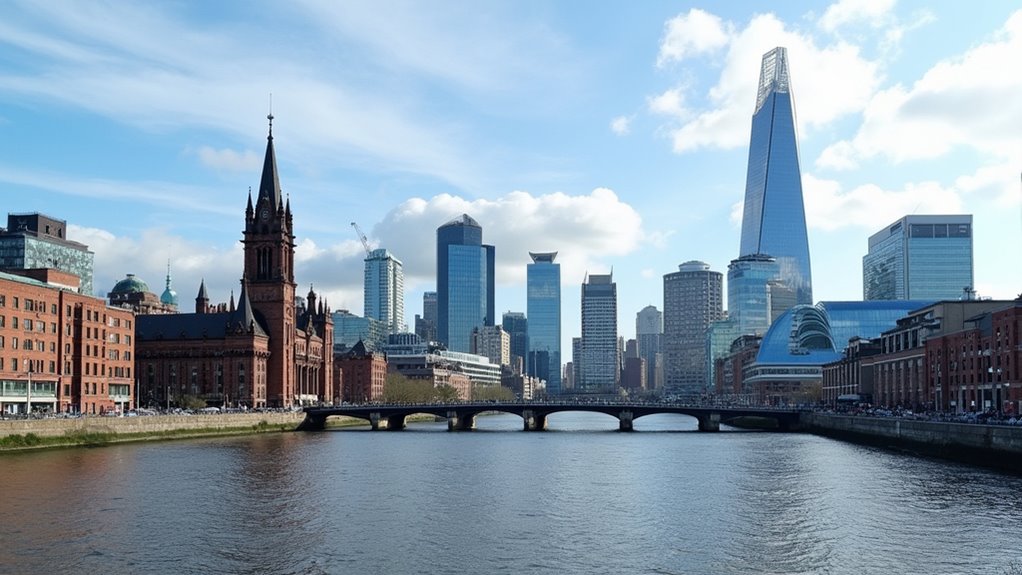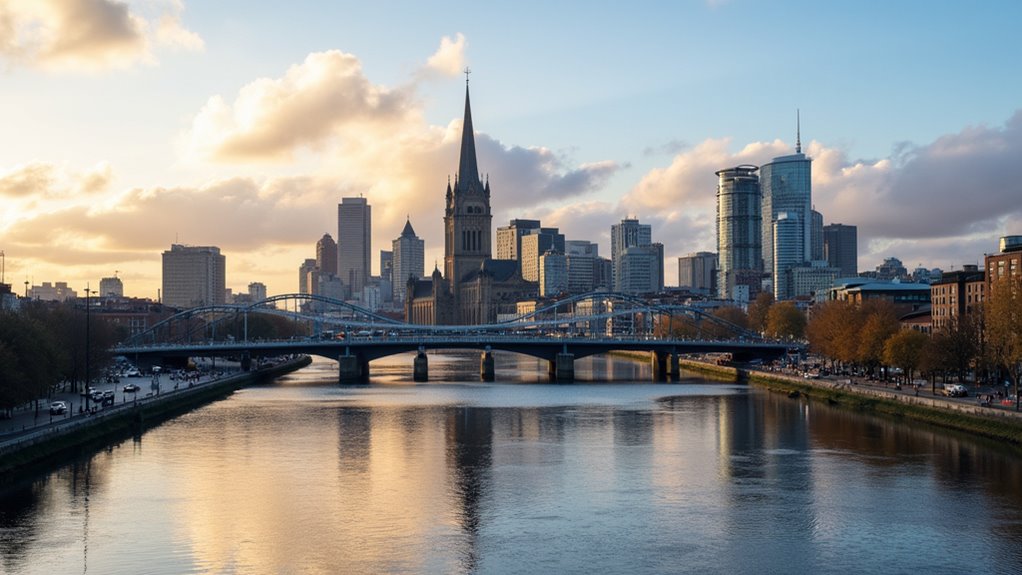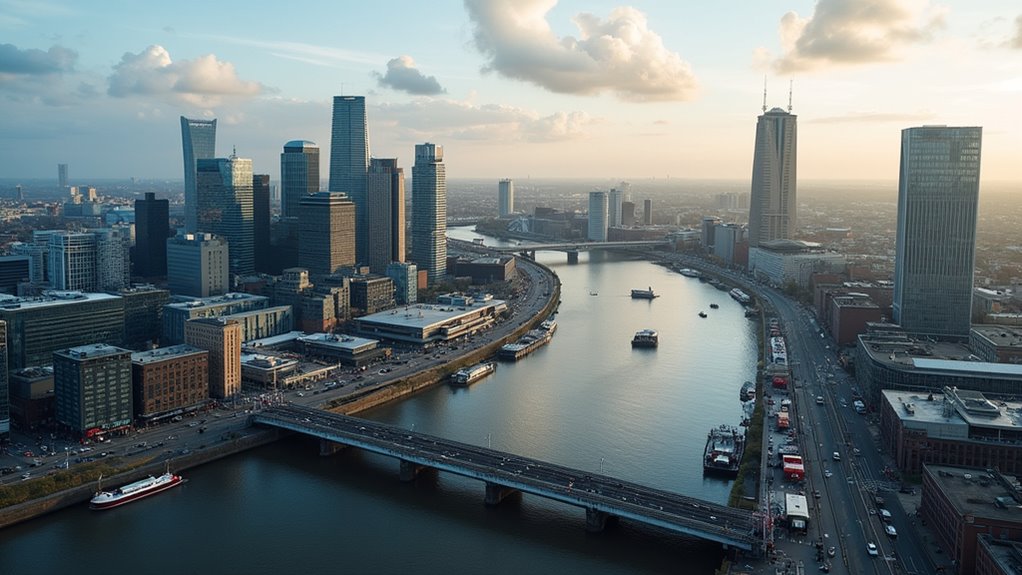Physical Address
304 North Cardinal St.
Dorchester Center, MA 02124
Physical Address
304 North Cardinal St.
Dorchester Center, MA 02124

Fierce rivals in the sporting arena, Manchester and Liverpool's storied history as industrial powerhouses and cultural hubs has fueled an enduring regional rivalry.
You don’t have to look far to see the rivalry between Manchester and Liverpool. Just turn on the TV during a match between Manchester United and Liverpool FC, and you’ll witness the intensity and passion that define these two iconic northern cities. From their storied industrial histories to their vibrant cultural scenes, Manchester and Liverpool have long competed for supremacy in the UK. What’s the real story behind this enduring rivalry? Let’s plunge into it and explore.

The industrial competition between Manchester and Liverpool has its origins in the 18th century, when Manchester was a dominant northern city with a large population and a thriving textile industry.
However, Liverpool’s port grew critical to the cotton trade by the late 18th century, surpassing Manchester’s economic influence. The rivalry between the two cities intensified as they competed for dominance in the cotton trade. The cities were connected by infrastructure like the Bridgewater Canal, Mersey and Irwell Navigation, and the Liverpool-Manchester Railway, enabling raw material transport.
The 1894 Manchester Ship Canal further intensified the rivalry by bypassing Liverpool’s docks, while Liverpool’s “Empire’s second city” status in the late 19th and early 20th centuries widened the inter-city competition.
Beyond the industrial origins, the fierce football rivalry between Liverpool and Manchester United has captivated generations of fans.
The historical records show a closely contested affair, with Manchester United holding a slight edge in total wins, but Liverpool dominating at home. Recent matches have seen Liverpool’s attacking prowess outpace their rivals.
Recent form favors the Reds, with their attacking prowess outpacing their rivals. However, defensive vulnerabilities on both sides have led to high-scoring encounters.
While Manchester United boasts a greater trophy haul, Liverpool has matched them in European success.
With massive global fanbases, this “Northwest Derby” remains one of the most-watched fixtures in world football, showcasing the intensity of this iconic rivalry.

Manchester and Liverpool have both made notable cultural contributions that have resonated worldwide.
Manchester is renowned for its musical heritage, with iconic bands like The Smiths, Oasis, and Joy Division shaping the city’s sound. Liverpool’s iconic waterfront skyline and transport links appeal to travelers and business travelers. Liverpool, on the other hand, holds the Guinness World Record as the World Capital City of Pop, boasting more number one singles than any other city globally. The Beatles, a cornerstone of Liverpool’s cultural identity, have greatly influenced the city’s international recognition.
Manchester’s musical heritage has been shaped by iconic bands like The Smiths, Oasis, and Joy Division.
Both cities feature prominent music venues and have contributed notably to British pop culture. While Manchester’s media influence is less prominent, Liverpool’s thriving film industry and TV productions have added to its cultural exports.
While Manchester and Liverpool have long been locked in an industrial-era competition rooted in textiles versus shipping, the cities’ economic evolution has taken divergent paths in the 21st century.
Manchester created 14,000 professional services jobs from 2010-2015, while Liverpool added 7,547 digital and creative roles. Projected employment growth favors Manchester at 3.8% versus Liverpool’s 2.6% from 2015-2020. The construction of the Manchester Ship Canal intensified rivalry and resentment between the two cities in the past, but their current economic trajectories highlight the cities’ distinct specializations.
Liverpool’s GVA growth has outpaced Manchester’s post-recession recovery. The cities’ specialized growth reflects Manchester’s strength in professional services and Liverpool’s focus on tech, AI, and life sciences.
Both emphasize STEM education to support their tech and health sectors.

As you consider the demographic and social trends in Manchester and Liverpool, you’ll find that the cities exhibit distinct profiles. With Manchester’s population estimated at 2.8 million by 2025 and Liverpool’s at nearly 930,000, the urban landscapes differ considerably.
Looking beyond the demographic and social trends, the future outlook for Manchester and Liverpool paints a promising picture of economic growth and infrastructure development.
Manchester is forecast to outpace the UK’s average GVA growth at 2.1% annually, driven by its thriving knowledge-intensive industries. Knowledge-intensive industries are crucial for Manchester’s future growth.
Meanwhile, Liverpool’s proposed “Northern Arc” plan aims to boost economic output by £90bn over 15 years.
Both cities emphasize leveraging their transport links, with the Liverpool-Manchester rail upgrades projected to add £7bn annually to the UK economy.
The two cities’ collaborative approach to talent development and innovation-led growth in sectors like green tech and life sciences further strengthens their shared vision for the future.

Manchester and Liverpool have emerged as powerhouses in the North, demonstrating resilience and a steadfast commitment to economic growth and infrastructure development.
Though the cities boast nearly identical costs of living, key differences emerge:
While cost of living is comparable, Manchester and Liverpool have distinct economic and cultural profiles that set them apart.
Manchester and Liverpool’s rivalry has endured for centuries, shaping the cultural fabric of the North. Whilst their football clubs battle on the pitch, the cities’ innovative spirit and resilience continue to redefine the region’s economic and social landscape. Take the rise of Liverpool’s thriving tech hub, for example – a reflection of the cities’ ability to adapt and thrive, even in the face of fierce competition. Ultimately, this rivalry has become a symbol of the North’s unwavering determination and unparalleled dynamism.